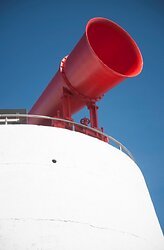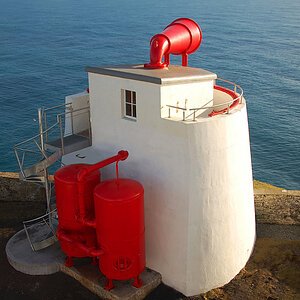Foghorn
 The Foghorn would have been heard for miles around (image by Frank Bradford)
The Sumburgh Head Foghorn is a striking landmark. Recently restored and re-painted, the bright red trumpet points out to sea as it has since it was built in 1905 and put into operation in 1906.
The Foghorn would have been heard for miles around (image by Frank Bradford)
The Sumburgh Head Foghorn is a striking landmark. Recently restored and re-painted, the bright red trumpet points out to sea as it has since it was built in 1905 and put into operation in 1906.
The Foghorn was last sounded in 1987. During the refurbishment of Sumburgh Head the Foghorn was restored to working order and will now sound again on special occasions.
The Sumburgh Foghorn is powered by low-pressure compressed air, generated in the engines and compressors in the Engine Room. It takes around 25psi to power the foghorn; compressed air is stored in the receiver tanks, which are connected to the Foghorn via an underground pipe. To sound the Foghorn, a valve is opened and air whooshes along the pipe to the Foghorn where it passes over a siren. A motor controls the flow of air to the siren, which gives the Sumburgh Foghorn its character, which is a seven second blast every 90 seconds.
Prior to the Foghorn tower being built, a bell was used to warn mariners of potential danger. The implementation of the Foghorn was a big improvement, as the sound could be heard up to 20 miles away in poor visibility.
 A new spiral staircase has been installed to replace the original ladder, allowing easier access for visitors to climb the tower and enjoy the view, as well as get close to the Foghorn itself and appreciate the size of it and the noise it would have made. Ex-Lightkeepers have spoken of the ‘terrible racket’ of the horn – although the volume would have undoubtedly been appreciated by those at sea blinded by the fog.
A new spiral staircase has been installed to replace the original ladder, allowing easier access for visitors to climb the tower and enjoy the view, as well as get close to the Foghorn itself and appreciate the size of it and the noise it would have made. Ex-Lightkeepers have spoken of the ‘terrible racket’ of the horn – although the volume would have undoubtedly been appreciated by those at sea blinded by the fog.
On the top of the tower wall, there are tracks. The purpose of these tracks was so that the Lightkeeper could move the horn to face the direction of where the fog was thickest – to better direct the sound to those who would need it. This however caused some confusion as sailors did not always know which direction the sound was coming from and could not judge distances properly as a result. The Northern Lighthouse Board issued an instruction that all Lighthouse Foghorns should be fixed in the position they were in and not moved again. This is why the Foghorn at Sumburgh sits slightly off centre!
Climb to the top of the tower and, on a clear day, there are uninterupted views across the sea where you can even see Fair Isle!

